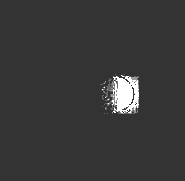It looks like you're using an Ad Blocker.
Please white-list or disable AboveTopSecret.com in your ad-blocking tool.
Thank you.
Some features of ATS will be disabled while you continue to use an ad-blocker.
share:
Working for me, but here's the text just in case:
I think the 'NE' is the giveaway!
A photo is circulating around the web in which tiny images of Earth, Jupiter and Venus can allegedly be seen from the skyline of Mars.
While the astounding image looks very cool, many people are saying the picture is, unfortunately, a fake.
“The landscape color is a bit too saturated for Mars,” explained a blogger for Discover Magazine. “The sky’s the wrong color. The clouds are too numerous, the wrong color as well, and they have that ‘rendered by software’ look to them.”
The blogger admits that while he has experience, his “gut sense” is not always correct—though he does go on to describe the image’s many flaws, including the small “NE” in the bottom left corner of the image, which is used in planetarium software to show directions.
NASA has not commented on the circulating photo—meaning that it is more than likely a fabricated image. Still, it is interesting to guess what the Mars skyline would look like, and hopefully NASA’s Curiosity rover will soon show us what we could previously only imagine in our science fiction fantasies.
I think the 'NE' is the giveaway!
alfa1
Phage
Fake. No stars.
So I grab the image and turn up the contrast to ridiculous levels to see if any stars come up out of the gloom.
What I find instead is the moon having a very sharp left edge, as if the moon has been cut and pasted from elsewhere, or at the very least, processed seperately.
As the caption says:
This color image required a fair amount of processing to make a nice-looking release.
More than at first glance.
I suspect the earth and moon were indeeed processed seperately, then pasted onto a blank black background into their supposed proper positions.
edit on 29-12-2013 by alfa1 because: (no reason given)
What program did you use and what were the exact steps you took to find this?
ah...nevermind. I'm guessing you just turned up the white levels on it in photoshop? That's what I just did and got the same result
edit on
31-12-2013 by MrPlow because: (no reason given)
I ran a copy through fotoforensics and got this:

Those edges are present in this one as well

Those edges are present in this one as well
edit on 31-12-2013 by MrPlow because: (no reason given)
It is so magnificently beautiful, just looking at it, not once do you think "Meat sacks live there, ya know?"
violet
Is this a photograph taken from mars or just an artists rendition of how they think it looks?
It doesn't look right. I thought we would lol like astar from Mars, the way Mars looks to us. Earth looks to big.
The HiRISE camera that took this image is a 0.5 m telescope, the largest one to leave Earth's orbit. en.wikipedia.org...
reply to post by MrPlow
The article in the OP already acknowledges that the images went through some processing/manipulation to look this good, such as changing the brightness of Earth and the Moon. This sort of processing could require some masking, or even the overlaying of separate Earth and moon images over a black background.
The image as shown is meant for public consumption (i.e., to be a pretty picture) and not for scientific research, so I can undrstand why they might "photoshop" it.
HOWEVER, and having said that, the artifacts in your image look to be jpg compression artifacts -- namely a "blocking artifact".
Blocking artifacts occur in jpg compression because part of that compression involves the jpg algorithm "interpolating" the color of pixels based on neighboring pixels . This interpolation reduces the file size (thus compressing the image). Sometimes when there is a color against a homogenous field of another color, such as the blue Earth against black space, this interpolation of pixels (remember -- the interpolation is based on neighboring pixels) goes a little "wrong", and the result is a non-defined edge between the two colors. The hallmark of a blocking artifact is that the artifact occurs in groups of 8-pixel x 8-pixel blocks, hence the name.
Here is a tree against a blue sky that shows a blocking artifact where the tree meets the sky:
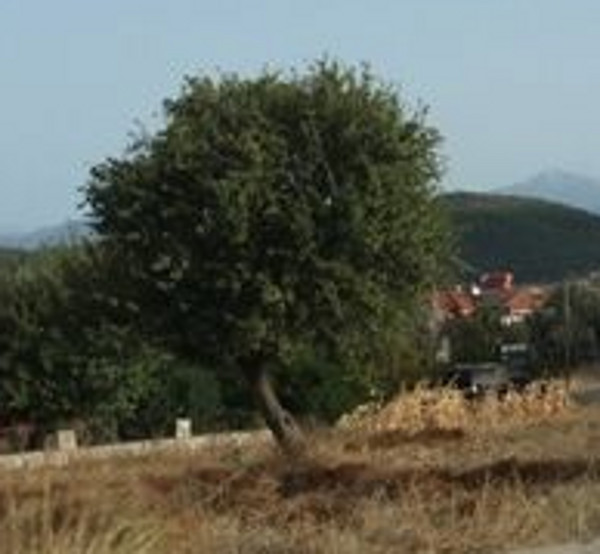
So while there was certainly some "photoshopping" going on here (i.e., processing of the raw image to make it look nicer), and the article even says there was, I think that undefined edge around the Earth and Moon in your image could be due to blocking artifacts, as well as having something to do with the image manipulation/processing.
The article in the OP already acknowledges that the images went through some processing/manipulation to look this good, such as changing the brightness of Earth and the Moon. This sort of processing could require some masking, or even the overlaying of separate Earth and moon images over a black background.
The image as shown is meant for public consumption (i.e., to be a pretty picture) and not for scientific research, so I can undrstand why they might "photoshop" it.
HOWEVER, and having said that, the artifacts in your image look to be jpg compression artifacts -- namely a "blocking artifact".
Blocking artifacts occur in jpg compression because part of that compression involves the jpg algorithm "interpolating" the color of pixels based on neighboring pixels . This interpolation reduces the file size (thus compressing the image). Sometimes when there is a color against a homogenous field of another color, such as the blue Earth against black space, this interpolation of pixels (remember -- the interpolation is based on neighboring pixels) goes a little "wrong", and the result is a non-defined edge between the two colors. The hallmark of a blocking artifact is that the artifact occurs in groups of 8-pixel x 8-pixel blocks, hence the name.
Here is a tree against a blue sky that shows a blocking artifact where the tree meets the sky:

So while there was certainly some "photoshopping" going on here (i.e., processing of the raw image to make it look nicer), and the article even says there was, I think that undefined edge around the Earth and Moon in your image could be due to blocking artifacts, as well as having something to do with the image manipulation/processing.
edit on 12/31/2013 by Soylent Green Is People because: (no reason given)
WonderBoi
The fool says in his heart: "There is no God".
"But whosoever shall say 'Thou Fool' shall be in danger of hell fire." - Mathew 5:22
Back on topic...cool, interesting pic, even if it's processed. The universe is quite amazing.
reply to post by alfa1
So you are saying this photo is the outer space equivalent to a model being photoshopped skinnier.
So you are saying this photo is the outer space equivalent to a model being photoshopped skinnier.
Stuship
reply to post by alfa1
So you are saying this photo is the outer space equivalent to a model being photoshopped skinnier.
That's a good analogy.
Several years ago, before the Babb/BAUT/Cosmoquest forum turned fascist, I posted a little experiment to illustrate how jpg compression artifacts occur:
1. From the "Start" menu on your computer, open up Programs>Accessories>Paint.
2. Set your image attributes to 2 x 2 inches.
3. Select the "Draw Line" option and select the broadest width.
4. Select "Draw Ellipse" and draw a circle:
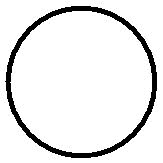
5. Save this as a .bmp file (circle1.bmp).
6. Now click on the bucket fill icon and select the red color.
7. Click on the inside & outside of the circle to fill it in:
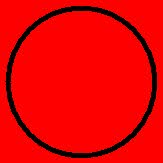
That looks nice & neat.
8. Save this as circle2.bmp
9. Open the circle1.bmp file again.
10. Save it as a jpeg file (circle1.jpg):
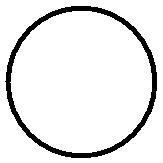
11. Click on the bucket fill icon and select the red color again.
12. Click on the inside & outside of the circle to fill it in:
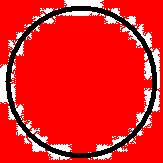
Whoa! Yuck, what happened? When you saved it as a jpeg, it compressed the bits around the circle. If you check the size of the files you saved, you'll find the .bmp files are ~104kb, whereas the .jpg files are ~4kb.
The moral of the story is that jpegs are great for storing & transmitting images efficiently, but are not good for any sort of high-resolution photoanalysis.
Hope this helps.
Stuship
reply to post by alfa1
So you are saying this photo is the outer space equivalent to a model being photoshopped skinnier.
No, it's the equivalent of making hard to see blemishes really pop out.
reply to post by Saint Exupery
Superb post. If you could do the same for youtube video compression and make it mandatory viewing for every conspiracy forum we could dispose of a lot of internet clutter.
Superb post. If you could do the same for youtube video compression and make it mandatory viewing for every conspiracy forum we could dispose of a lot of internet clutter.
reply to post by GaryN
thanks for enlightening me.
I have to admit, I did think the clouds were odd... but figured it was not necessarily moisture in the air...
Live and learn,
Thanks again,
thanks for enlightening me.
I have to admit, I did think the clouds were odd... but figured it was not necessarily moisture in the air...
Live and learn,
Thanks again,
Zanti Misfit
reply to post by CaptainBeno
This Pic. was taken by one of the Apollo Missions . A View of Earth from the Moons Surface . Notice the Lack of Stars in the Picture . Were they Filtered out for a Better View , or is the resolution not detailed enough to Show them ?
i297.photobucket.com...edit on 30-12-2013 by Zanti Misfit because: (no reason given)
You've got the two problems of angular resolution and contrast. On Earth, the Sun and Moon are only 1 degree wide. The stars are a thousandth of that. When you are lucky to get a hundred pixels for the Earth, you get less than one pixel for a star. Then there is the relative contrast. Earth and Moon are thousands of times brighter that the stars. To get a photograph of the Earth and Moon, you need a shutter speed of a few hundreds of a second, to get a photograph of the stars, that needs a shutter speed of 6 seconds or more.
greenday1978
Why start a thread using a fake photo?
How is it a fake photo?
reply to post by greenday1978
Explain?.....................and your proof is?
I did not "fake" the photo. And if it is a fake photo , surely this raises it's own questions..........so maybe you are right "WHY??"
Explain?.....................and your proof is?
I did not "fake" the photo. And if it is a fake photo , surely this raises it's own questions..........so maybe you are right "WHY??"
MrPlow
I ran a copy through fotoforensics and got this:
Those edges are present in this one as welledit on 31-12-2013 by MrPlow because: (no reason given)
... off to find out about "fotoforensics" software... thanks!
new topics
-
Ed Dowd some good news
Medical Issues & Conspiracies: 3 hours ago -
Anyone like the Scorpions?
Music: 3 hours ago -
What if this is true?
2024 Elections: 4 hours ago -
Merry-Go-Round Ride
Short Stories: 6 hours ago -
It's toast
General Chit Chat: 10 hours ago -
Man Stabbed or Cardiac arrest on Westminster Bridge, London, UK
Mainstream News: 11 hours ago
top topics
-
A fix for the Trans players in sports
Social Issues and Civil Unrest: 13 hours ago, 16 flags -
Petition Calling for General Election at 564,016 and rising Fast
Political Issues: 16 hours ago, 14 flags -
What if this is true?
2024 Elections: 4 hours ago, 10 flags -
Man Stabbed or Cardiac arrest on Westminster Bridge, London, UK
Mainstream News: 11 hours ago, 7 flags -
It's toast
General Chit Chat: 10 hours ago, 7 flags -
Merry-Go-Round Ride
Short Stories: 6 hours ago, 5 flags -
Ed Dowd some good news
Medical Issues & Conspiracies: 3 hours ago, 4 flags -
Anyone like the Scorpions?
Music: 3 hours ago, 3 flags
active topics
-
International Criminal Court Issues Arrest Warrant For Netanyahu
Mainstream News • 48 • : JJproductions -
Ok this is some BS now WTH
Rant • 17 • : tamusan -
What if this is true?
2024 Elections • 21 • : AlexandrosOMegas -
A fix for the Trans players in sports
Social Issues and Civil Unrest • 19 • : Macenroe1982 -
France gives Ukraine license to fire long-range missiles at Russia
World War Three • 40 • : cherokeetroy -
Ed Dowd some good news
Medical Issues & Conspiracies • 2 • : annonentity -
Results of the use of the Oreshnik missile system in Dnepropetrovsk
World War Three • 218 • : Imhere -
Anyone like the Scorpions?
Music • 2 • : Flyingclaydisk -
Merry-Go-Round Ride
Short Stories • 5 • : randomuser2034 -
Russia Ukraine Update Thread - part 3
World War Three • 6876 • : worldstarcountry

